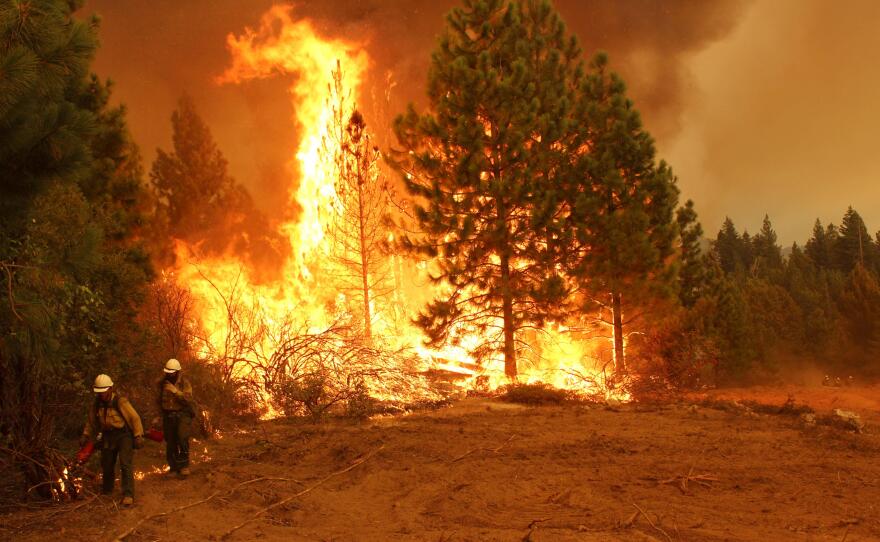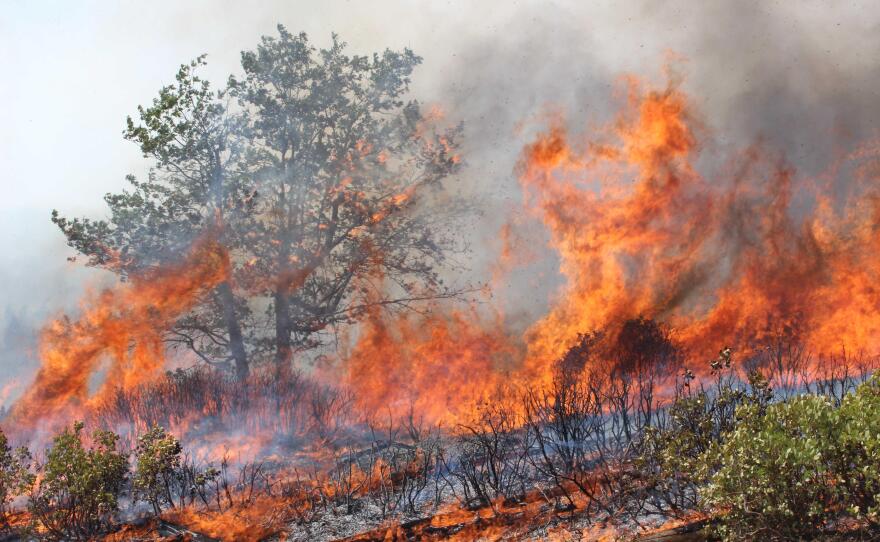TUOLUMNE CITY, Calif. (AP) — In the midst of a foreboding canyon scorched bare by the Sierra Nevada's most destructive fire in centuries, tiny ferns unfurl along a spring, black oaks push through charred soil normally blanketed with pine needles and a hawk soars above towering dead and denuded trees.

Just four weeks after the most intense day of California's Rim Fire — when wind and extremely arid conditions created a conflagration that turned 30,000 acres of dense conifers and oaks into a moonscape — life is returning as the forest begins to repair itself.
"It's a pretty harsh environment, but we know fire can be good and that species depend on it, and that fire allows seeds to germinate," said Sean Collins of the South Central Sierra Incident Command Team as he examined tiny patches of greenery amid a disorienting sepia-tone landscape.
"Next spring we'll see a lot of wildflowers and plants that haven't been seen around here for a long, long time. In 20 years, we'll see something really nice. But it will take 200 years at least for it to grow back the way it was," he said.
hunter's illegal campfire ignited California's third-largest fire in history Aug. 17 in Stanislaus National Forest, launching a 400-square-mile mosaic of destruction interspersed with unaltered refuges across the 1,400-square-mile forest. It scorched canyon walls in 25 watersheds nurturing sensitive trout and supplying drinking water to millions of Californians before spreading into Yosemite National Park.
Experts estimate the Stanislaus lost 1 billion board feet of potential lumber in a forest that balances recreation and natural beauty with select timber sales. Forest archeologists are assessing damage and the potential loss of historic logging camps, Gold Rush cabins and native Miwok artifacts.
But the conundrum facing forest ecologists is what to do now in an agency that is transitioning from one with a heavy focus on timber production to one whose actions now take into consideration the impacts of climate change, carbon sequestration and habitat.
Decades ago when the last fires swept through the Stanislaus, foresters replanted vast stands of conifers. Absent funding to manage those forests, and lacking a market for small trees that could be sold from thinning, they had stood relatively untouched.
Inspections this week revealed that those were some of the most heavily devastated from a fire that has become a laboratory for forest management in an era of rapid environmental changes brought by climate warming.
"When they planted those plantations, the foresters wanted to grow forest for wood production," said federal forest ecologist Hugh Safford a day after surveying the impact. "Now there are a lot of things that we are trying to do that we have to take into consideration: watershed protection, wildlife habitat restoration, climate change resilience. That's a big switch in thinking."

The fire's timing comes as the Stanislaus has become the national leader in charting the agency's new path in a time of frugal government. Unlike neighboring Yosemite, where a history of prescribed burns left less lasting damage, the forest service has not been aggressively proactive about managing much of the vast forestlands.
"We have a heck of a time paying to do this work," Safford said. "But when you look at how the Rim Fire burned, one of the things you see is that in the places where they got some thinning done, it worked."
Safford and other scientists are hoping that their observations from the Rim Fire lead to research over the coming years that will improve forest management across the arid West.
"There's going to be a lot of pressure to do logging and replanting on the landscape. Those are important tools we have, but we have a lot of tools and we need to find ways to use them," he said.
Whether foresters will replant what they've described as a moonscape — or allow it to regenerate as shrubby chaparral is just one of the many decisions that will be made.
Today, miles of charred pines and firs with blackened trunks show where crews set backfires to reduce fuel in a herculean effort to keep the fire out of mountain communities.
Even as stumps still smolder elsewhere, crews are working to at least shore up ridges ahead of the state's rain and snow season that begins next month.
On Wednesday along Dodge Ridge, where bulldozers created a 40-foot fire break by uprooting a swath of trees along a popular alpine ski trail, excavators were leveling berms of logs and soft soil while hand crews worked with chain saws, axes and shovels to restore the terrain and launch the regenerative process.
"If you take a look at this ground, there's a lot of seed in this soil," added Glenn Harris, a resource adviser. "It's going to come back. Eventually."






